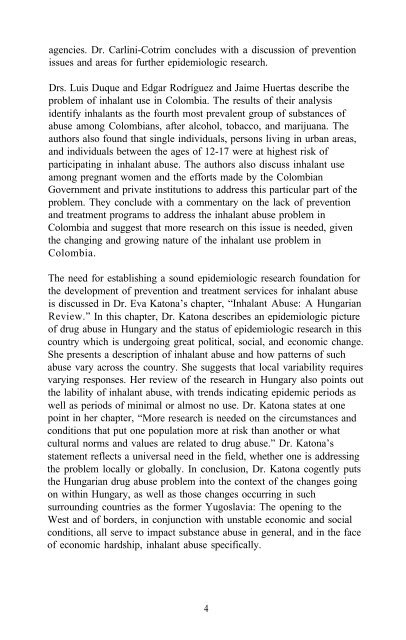Epidemiology of Inhalant Abuse - Archives - National Institute on ...
Epidemiology of Inhalant Abuse - Archives - National Institute on ...
Epidemiology of Inhalant Abuse - Archives - National Institute on ...
Create successful ePaper yourself
Turn your PDF publications into a flip-book with our unique Google optimized e-Paper software.
agencies. Dr. Carlini-Cotrim c<strong>on</strong>cludes with a discussi<strong>on</strong> <str<strong>on</strong>g>of</str<strong>on</strong>g> preventi<strong>on</strong><br />
issues and areas for further epidemiologic research.<br />
Drs. Luis Duque and Edgar Rodríguez and Jaime Huertas describe the<br />
problem <str<strong>on</strong>g>of</str<strong>on</strong>g> inhalant use in Colombia. The results <str<strong>on</strong>g>of</str<strong>on</strong>g> their analysis<br />
identify inhalants as the fourth most prevalent group <str<strong>on</strong>g>of</str<strong>on</strong>g> substances <str<strong>on</strong>g>of</str<strong>on</strong>g><br />
abuse am<strong>on</strong>g Colombians, after alcohol, tobacco, and marijuana. The<br />
authors also found that single individuals, pers<strong>on</strong>s living in urban areas,<br />
and individuals between the ages <str<strong>on</strong>g>of</str<strong>on</strong>g> 12-17 were at highest risk <str<strong>on</strong>g>of</str<strong>on</strong>g><br />
participating in inhalant abuse. The authors also discuss inhalant use<br />
am<strong>on</strong>g pregnant women and the efforts made by the Colombian<br />
Government and private instituti<strong>on</strong>s to address this particular part <str<strong>on</strong>g>of</str<strong>on</strong>g> the<br />
problem. They c<strong>on</strong>clude with a commentary <strong>on</strong> the lack <str<strong>on</strong>g>of</str<strong>on</strong>g> preventi<strong>on</strong><br />
and treatment programs to address the inhalant abuse problem in<br />
Colombia and suggest that more research <strong>on</strong> this issue is needed, given<br />
the changing and growing nature <str<strong>on</strong>g>of</str<strong>on</strong>g> the inhalant use problem in<br />
Colombia.<br />
The need for establishing a sound epidemiologic research foundati<strong>on</strong> for<br />
the development <str<strong>on</strong>g>of</str<strong>on</strong>g> preventi<strong>on</strong> and treatment services for inhalant abuse<br />
is discussed in Dr. Eva Kat<strong>on</strong>a’s chapter, “<str<strong>on</strong>g>Inhalant</str<strong>on</strong>g> <str<strong>on</strong>g>Abuse</str<strong>on</strong>g>: A Hungarian<br />
Review.” In this chapter, Dr. Kat<strong>on</strong>a describes an epidemiologic picture<br />
<str<strong>on</strong>g>of</str<strong>on</strong>g> drug abuse in Hungary and the status <str<strong>on</strong>g>of</str<strong>on</strong>g> epidemiologic research in this<br />
country which is undergoing great political, social, and ec<strong>on</strong>omic change.<br />
She presents a descripti<strong>on</strong> <str<strong>on</strong>g>of</str<strong>on</strong>g> inhalant abuse and how patterns <str<strong>on</strong>g>of</str<strong>on</strong>g> such<br />
abuse vary across the country. She suggests that local variability requires<br />
varying resp<strong>on</strong>ses. Her review <str<strong>on</strong>g>of</str<strong>on</strong>g> the research in Hungary also points out<br />
the lability <str<strong>on</strong>g>of</str<strong>on</strong>g> inhalant abuse, with trends indicating epidemic periods as<br />
well as periods <str<strong>on</strong>g>of</str<strong>on</strong>g> minimal or almost no use. Dr. Kat<strong>on</strong>a states at <strong>on</strong>e<br />
point in her chapter, “More research is needed <strong>on</strong> the circumstances and<br />
c<strong>on</strong>diti<strong>on</strong>s that put <strong>on</strong>e populati<strong>on</strong> more at risk than another or what<br />
cultural norms and values are related to drug abuse.” Dr. Kat<strong>on</strong>a’s<br />
statement reflects a universal need in the field, whether <strong>on</strong>e is addressing<br />
the problem locally or globally. In c<strong>on</strong>clusi<strong>on</strong>, Dr. Kat<strong>on</strong>a cogently puts<br />
the Hungarian drug abuse problem into the c<strong>on</strong>text <str<strong>on</strong>g>of</str<strong>on</strong>g> the changes going<br />
<strong>on</strong> within Hungary, as well as those changes occurring in such<br />
surrounding countries as the former Yugoslavia: The opening to the<br />
West and <str<strong>on</strong>g>of</str<strong>on</strong>g> borders, in c<strong>on</strong>juncti<strong>on</strong> with unstable ec<strong>on</strong>omic and social<br />
c<strong>on</strong>diti<strong>on</strong>s, all serve to impact substance abuse in general, and in the face<br />
<str<strong>on</strong>g>of</str<strong>on</strong>g> ec<strong>on</strong>omic hardship, inhalant abuse specifically.<br />
4
















